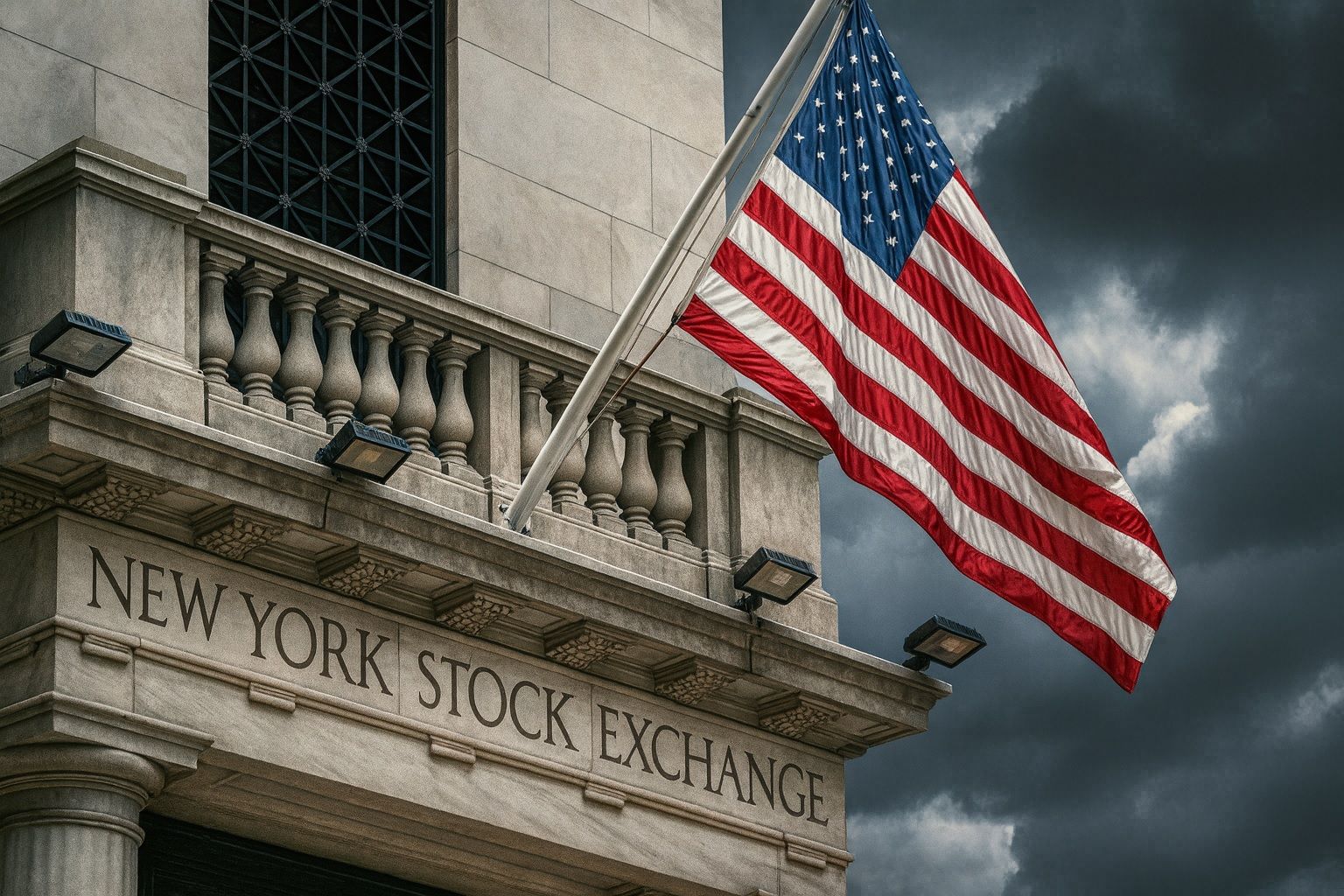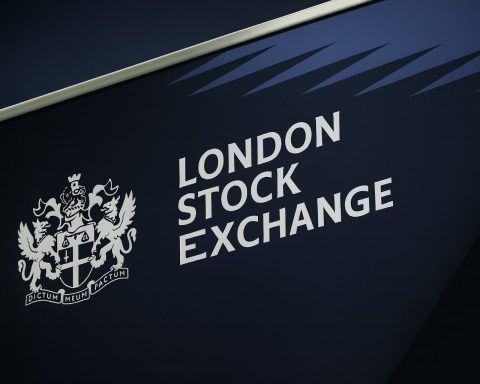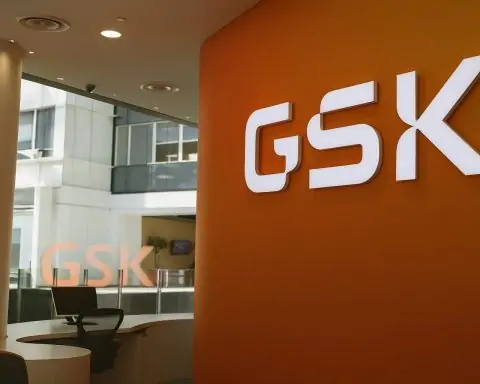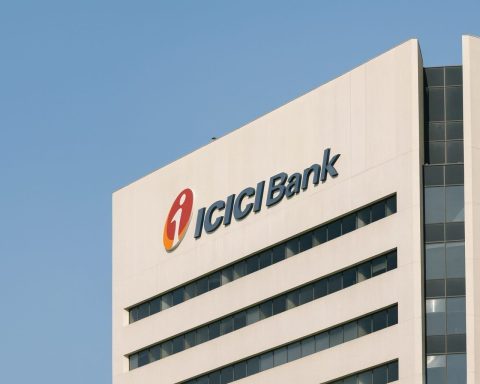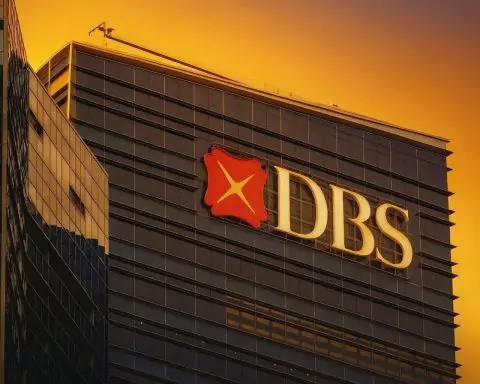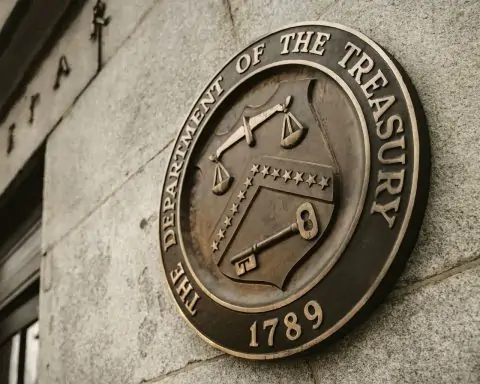- Bond Frenzy After Powell: On Oct 14, Fed Chair Jerome Powell signaled more rate cuts ahead and an imminent end to quantitative tightening (QT), sparking a bond rally [1] [2]. Short-term yields fell sharply, with the 2-year Treasury (which tracks Fed policy expectations) tumbling toward 3.47%, near lows not seen since 2022 [3]. The 10-year yield dipped to about 4.02%, levels last seen in early September [4].
- Stocks Mixed, Gold Soars: Equity markets were mixed. The Dow and S&P 500 eked out gains after early losses, while the tech-heavy Nasdaq lagged [5]. Safe-havens jumped: gold hit fresh records above $4,100/oz [6] [7] as investors sought shelter, and even Bitcoin briefly tumbled amid risk-off sentiment [8]. Oil prices also slid on demand worries and trade jitters.
- Trade War Flashpoints: Global equities were volatile amid a flare-up in the U.S.-China trade war. President Trump’s threats of 100% tariffs on Chinese imports (effective Nov. 1) and China’s retaliatory export controls rattled markets in recent days [9]. This “Trade War 2.0” shock knocked U.S. stocks down sharply on Oct. 10 [10] and sent yields lower on safe-haven flows [11]. Moody’s economists warn that renewed tariffs could “fuel U.S. inflation and slow global growth” [12].
- Fed Outlook & Inflation: With inflation still above 2% (around 2.9% currently), Fed officials remain divided. Powell’s speech stressed that inflation pressures largely stem from tariffs, not underlying demand [13]. Most Wall Street strategists still expect two more Fed rate cuts by year-end [14] [15]. However, concerns persist that cutting too fast could reignite inflation. As Collin Martin of Schwab notes, “We don’t expect long-term yields to fall much further… Ten-year Treasuries can still hold above 4% even as the Fed cuts rates” [16].
- Analysts’ Take: Experts are cautious. “The Powell speech was somewhat more dovish than I expected… It gave me more confidence in rate cuts coming before year-end,” says Chris Grisanti of MAI Capital [17]. But others point out that both inflation and a slowing jobs market threaten Fed goals. “You can’t have negative job growth and 4% GDP growth… something’s got to give,” notes Fed Governor Christopher Waller [18]. Many forecasters foresee only a gradual decline in yields: a Reuters poll projects the 2-year yield around 3.40% in six months (down from ~3.47% now) and the 10-year near 4.10% [19]. Most analysts see a steepening yield curve as short rates fall faster than long rates [20].
- Market Forecasts: Wall Street remains divided but generally optimistic on stocks. RBC Capital Markets has lifted its year-end S&P 500 target to ~6,250 (versus ~6,700 today) and even sees 7,100 by 2026 [21], citing a “dovish Fed and resilient earnings.” Goldman Sachs pegs year-end S&P at ~6,800 [22]. Yet the Bank of England warns equity valuations (especially in AI-tech) look “excessively high” and ripe for a “sudden correction” [23] if Fed or growth outlooks sour.
Fed’s Dovish Signal Drives Rally
After Fed Chair Jerome Powell’s Oct 14 speech to business economists in Philadelphia, U.S. bond markets surged. Powell confirmed the Fed’s intent to proceed “meeting-by-meeting” with policy cuts and suggested the central bank may halt its $40 billion/month balance-sheet runoff soon [24] [25]. His message – a familiar but balanced tone – calmed traders. 10-year Treasury yields plunged from about 4.1% into the low 4.0% range [26] [27], while 2-year yields dropped even more on expectations of aggressive rate easing.
Economists note that Powell emphasized weak hiring, not inflation, as a growing risk. He said layoffs and hiring remain “low” while inflation shows mostly only tariff-driven blips [28]. This shift suggests the Fed is now focusing more on jobs. Philadelphia Fed President Anna Paulson echoed that sentiment, calling two more cuts “appropriate” to avoid derailing productivity gains [29].
These dovish cues erased worries spurred by Trump’s trade threats. “Jay Powell dropped a major piece of news when he mentioned that the Fed could stop culling the size of its balance sheet… That’s a hidden source of relief,” noted Callie Cox of Ritholtz Wealth [30]. Indeed, the hint of ending quantitative tightening (QT) added extra downward pressure on yields. Columbia Threadneedle’s Ed Al-Hussainy said Powell’s comments on the Fed’s balance sheet provided a rare “smoke signal” for bond markets [31].
Treasuries Near Multiyear Lows
Two-year Treasury yields, which move most with Fed policy bets, plunged to about 3.47% on Oct 15 – a level not seen since 2022 [32]. Even the closely-watched three-month bill yield fell to around 5% amid these expectations. Benchmark 10-year yields eased to ~4.02% [33], and 30-year yields dipped near 4.62% [34]. The yield curve has therefore remained steep – a sign that markets expect short-term rates to fall faster than long-term rates.
Trading data and polls back this up. Interest-rate swaps imply roughly 1.25 percentage points of Fed cuts by end-2026 [35]. A Reuters poll (Oct 15) found strategists see the 10-year yield around 4.10% in 3–6 months and rising to ~4.17% in a year [36] [37]. By contrast, the 2-year yield is expected to creep down to ~3.35% by late 2026 [38] – meaning a significantly steeper curve. “We don’t expect long-term yields to fall much further, if at all,” said Collin Martin of Charles Schwab. Even with Fed cuts coming, stubborn inflation (and growing U.S. deficits) should keep the 10-year yield above 4% [39].
The rush into bonds was reinforced by trade angst. As one fund manager put it, it’s “right back to trade shenanigans” and downside growth risks [40]. On Oct 10–14, global bond indices outperformed, reflecting a defensive tilt. Bloomberg strategist Alyce Andres noted that Treasuries “continue to benefit from… flight-to-safety bids after President Trump’s threat to impose ‘massive’ new tariffs on China” [41]. In fact, when Trump stunned markets with 100% tariff threats, 10-year yields briefly dipped below 4.05% [42] before rebounding. Kathy Brooks at XTB summed up the mood: “The drop in equities and commodities is a clear sign of risk aversion… Money is instead moving into sovereign bonds.” [43]
Stocks and Safe-Havens: A Delicate Balance
With bonds rallying, U.S. stocks saw a mixed reaction. On Oct 14, the Dow Jones and S&P 500 ended modestly higher – recouping early losses – while the Nasdaq fell slightly [44]. Banks’ strong earnings helped lift the Dow, but tech shares were held back by trade worries. As veteran strategist Peter Cardillo observes, markets are trying to juggle conflicting “ears”: one listening to trade war rhetoric, the other to fundamentals [45].
Ahead of Powell’s speech, markets had already been volatile: the S&P 500 briefly sold off around Oct. 10 amid Trump’s tariff bombshell, wiping out its weekly gains [46]. That global rout saw the S&P crash 2.7% and the Nasdaq 3.6% on Oct. 10 [47] – the worst daily declines in months. In response, gold and Treasuries surged. By contrast, once Powell’s reassuring tone sank in, equities rebounded: in the mid-October session, “the bulls remain fully in charge,” noted Michael James of Rosenblatt Securities [48].
Safe-haven assets have been bid up. Gold just hit all-time highs above $4,100 per ounce [49] [50] as traders piled in. Even Bitcoin briefly fell as “risk aversion” set in [51]. Oil prices have slipped roughly 4% since early October, down to the high $50s for Brent and WTI, on demand concerns and the weaker risk appetite [52] [53]. On currencies, the dollar gave back some recent gains: the trade-weighted dollar index fell back to ~99, and the euro and yen strengthened modestly [54].
Outlook: Caution and Opportunities
How long can this rally last? Experts are split. Some like Wharton’s Jeremy Siegel argue that as long as inflation continues to cool, the Fed can “gently lower rates and extend the expansion” [55]. Indeed, many Wall Street strategists are still bullish: RBC raised its S&P 500 year-end target to ~6,250 and forecasts continued growth in 2026 (S&P ~7,100) [56]. Goldman Sachs similarly increased its 2025 target to about 6,800 [57], expecting that a dovish Fed plus healthy earnings will carry stocks higher.
Others urge caution. The Bank of England warned that U.S. tech/AI stock valuations look “excessively high” and vulnerable [58]. A small stumble in job data or a sudden trade war escalation could rattle investors. As Banc of America strategist Adam Turnquist notes, with fiscal and trade policy acting as wildcards, “no risk-free path” exists [59].
In sum, markets enter the second half of October with bonds rallying on Fed easing bets, equities at lofty levels, and trade tensions simmering. Traders will be watching upcoming data (including a delayed jobs report) and the Fed’s Oct. 28–29 meeting for clues. But for now, “the bulls remain fully in charge,” and investors are hedging their bets by owning both risky assets and havens – a classic flight-and-fight strategy in turbulent times [60] [61].
Sources: Market data and expert commentary from Reuters and Bloomberg [62] [63] [64] [65] [66] [67]; analysis from TechStock² (ts2.tech) [68] [69] [70] [71].
References
1. www.reuters.com, 2. www.swissinfo.ch, 3. www.reuters.com, 4. www.swissinfo.ch, 5. www.reuters.com, 6. ts2.tech, 7. www.reuters.com, 8. www.swissinfo.ch, 9. ts2.tech, 10. ts2.tech, 11. ts2.tech, 12. ts2.tech, 13. ts2.tech, 14. ts2.tech, 15. www.reuters.com, 16. www.reuters.com, 17. www.reuters.com, 18. ts2.tech, 19. www.reuters.com, 20. www.reuters.com, 21. ts2.tech, 22. ts2.tech, 23. ts2.tech, 24. www.reuters.com, 25. www.swissinfo.ch, 26. www.reuters.com, 27. www.swissinfo.ch, 28. www.swissinfo.ch, 29. ts2.tech, 30. www.reuters.com, 31. www.swissinfo.ch, 32. www.reuters.com, 33. www.swissinfo.ch, 34. www.reuters.com, 35. www.swissinfo.ch, 36. www.reuters.com, 37. www.reuters.com, 38. www.reuters.com, 39. www.reuters.com, 40. www.swissinfo.ch, 41. www.swissinfo.ch, 42. ts2.tech, 43. www.swissinfo.ch, 44. www.reuters.com, 45. www.reuters.com, 46. ts2.tech, 47. ts2.tech, 48. ts2.tech, 49. ts2.tech, 50. www.reuters.com, 51. www.swissinfo.ch, 52. ts2.tech, 53. www.reuters.com, 54. www.reuters.com, 55. ts2.tech, 56. ts2.tech, 57. ts2.tech, 58. ts2.tech, 59. www.reuters.com, 60. ts2.tech, 61. ts2.tech, 62. www.reuters.com, 63. www.reuters.com, 64. www.reuters.com, 65. www.swissinfo.ch, 66. ts2.tech, 67. ts2.tech, 68. ts2.tech, 69. ts2.tech, 70. ts2.tech, 71. ts2.tech
